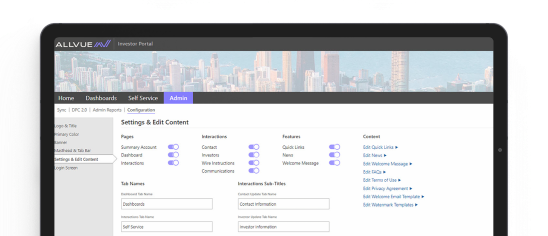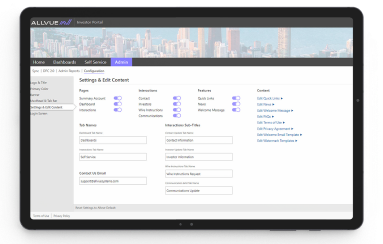
By: Allvue Team
May 12, 2023
One doesn’t need to travel deep into the private equity side of the accounting subreddit thread to start seeing a thorny, complex problem repeatedly cropping up – subsequent closes.
Subsequent Closing Interest- Private Equity
by u/crazybrain10 in Accounting
“The calculation of subsequent closing interest is really a daunting task,” as one user puts it. Or, as another: “Closing interest treatment is not clear and it’s calculation and rebalancing as complex as carried interest.”
Like so many of the fundamentals of private equity fund accounting, subsequent closings are a process that seem initial straightforward and simple only to, in practice, become increasingly complex. In this article we break down how the process and its close cousin, equalizations, work, and explain how Allvue’s fund accounting platform can help streamline and simplify these and other core back-office workflows.
DOWNLOAD: FREE PRIVATE EQUITY REPORTING TEMPLATES
What is a subsequent closing?
Subsequent closing definition
In the world of private equity, a subsequent closing is any fundraising round, or “closing,” that happens after the initial closing of the fund and before the final closing date.
When private equity firms are fundraising, it is not uncommon for them to break fundraising up into various rounds, which are also known as “closings.” Any closing that happens after the initial closing but before the final closing is known as a subsequent closing, or, sometimes, as an additional closing or add-on closing. But, because activity – especially, most notably, capital calls – may have already occurred within the fund, subsequent closings can trigger a variety of equalizations or true-up activity in order to compensate the pre-existing investors.
READ MORE: 5 STEPS TO PRIVATE EQUITY FUNDRAISING SUCCESS
Capital calls amidst closings
To better understand why, let’s walk through the following scenario:
Fund I, having secured a handful of investors who have signed the fund’s LPA, is now ready to call capital and make investments. The initial capital commitments, including the GP’s portion, are as follows:
| Investor |
Commitment ($) |
% Ownership |
| GP |
$1,000,000 |
10% |
| Investor A |
$3,000,000 |
30% |
| Investor B |
$3,000,000 |
30% |
| Investor C |
$3,000,000 |
30% |
| Total |
$10,000,000 |
100% |
Shortly after the initial close, Fund I makes a capital call of $1 million to fund investments and charge set up costs:
| Investor |
Commitment ($) |
% Ownership |
Drawdown 1 |
| GP |
$1,000,000 |
10% |
$100,000 |
| Investor A |
$3,000,000 |
30% |
$300,000 |
| Investor B |
$3,000,000 |
30% |
$300,000 |
| Investor C |
$3,000,000 |
30% |
$300,000 |
| Total |
$10,000,000 |
100% |
$1,000,000 |
And, three months after that capital call, continued fundraising efforts net a new investor. Fund I’s investor allocations now looks like the following:
| Investor |
Commitment ($) |
% Ownership |
Drawdown 1 |
| GP |
$1,000,000 |
8% |
$100,000 |
| Investor A |
$3,000,000 |
24% |
$300,000 |
| Investor B |
$3,000,000 |
24% |
$300,000 |
| Investor C |
$3,000,000 |
24% |
$300,000 |
| Investor D |
$2,500,000 |
20% |
$0 |
| Total |
$12,500,000 |
100% |
$1,000,000 |
With this additional investor’s commitment, the initial investors’ ownership has been diluted, yet the new investor hasn’t paid anything into the fund. Investor D could simply make the initial drawdown payment to balance things out, but this wouldn’t accurately compensate the initial investors and would eat into Fund I’s IRRs.
Instead, an equalization needs to be completed.
What is equalization?
Equalization is the process of truing-up all investors as if they had all joined a fund on its initial closing date. The process of doing so is multi-pronged.
First, Investor D pays in drawdown 1. But rather than making the payment to the fund, the payment is allocated across the initial investors, according to their percent ownership of the fund.
| Investor |
Commitment ($) |
% Ownership |
Drawdown 1 |
(Returned) / Called |
Adj. Drawdown 1 |
% Drawn |
| GP |
$1,000,000 |
8% |
$100,000 |
($20,000) |
$80,000 |
8% |
| Investor A |
$3,000,000 |
24% |
$300,000 |
($60,000) |
$240,000 |
8% |
| Investor B |
$3,000,000 |
24% |
$300,000 |
($60,000) |
$240,000 |
8% |
| Investor C |
$3,000,000 |
24% |
$300,000 |
($60,000) |
$240,000 |
8% |
| Investor D |
$2,500,000 |
20% |
$0 |
$200,000 |
$200,000 |
8% |
| Total |
$12,500,000 |
100% |
$1,000,000 |
$0 |
$1,000,000 |
8% |
Investor D also needs to make an equalization interest payment to the other investors, calculated as interest on the equalization amount based on the amount of time between the drawdown and the subsequent close, and at a rate stipulated by the LPA – often either a market rate of interest plus some basis points, or a hurdle rate of 8%, for example.
The challenge of subsequent closings for fund accounting teams
These calculations are relatively straightforward, but it is easy to imagine how they quickly become increasingly complex as factors multiply. Funds might have multiple capital calls they need to track between the initial and subsequent closing, as well as multiple closings with different investors onboarded at different times. Not to mention they need to keep track of details across multiple funds.
Additionally, while the above tables look at drawdowns as a single activity, fund accounting teams need to be able to break out those inflows by investment activity, management fees, fund expenses, etc. Legacy tools like Excel increase risk and further complicate the process rather than simplifying it.
Fund accounting teams need a better solution to meet their data management needs.
How Allvue’s Fund Accounting solution helps manage subsequent closings
Allvue’s Fund Accounting software solution helps alternative investment fund managers streamline subsequent closings by simplifying multiple workflows involved.

Our Fund Accounting solution facilitates the process of creating entries associated with a subsequent close, including rebalancing, interest calculations, and true-up entries. Our solution can be configured to calculate equalization rates based on either interest day count or interest rate so that it can match your fund requirements. And rebalancing can be calculated across entities – correcting all investments and expenses that were shared across funds.
The subsequent close process shouldn’t slow down your workflows or create added risk. Learn how Allvue’s Fund Accounting software solution can help empower superior investment decisions.


